6/🧵 Together, these findings produce a map of how we build meaning: from concept coding in the occipitotemporal cortex to relational integration in frontoparietal and striatal regions
Come see our full preprint here: www.biorxiv.org/content/10.1...
(Thanks for reading!)
24.06.2025 13:49 — 👍 7 🔁 1 💬 1 📌 0
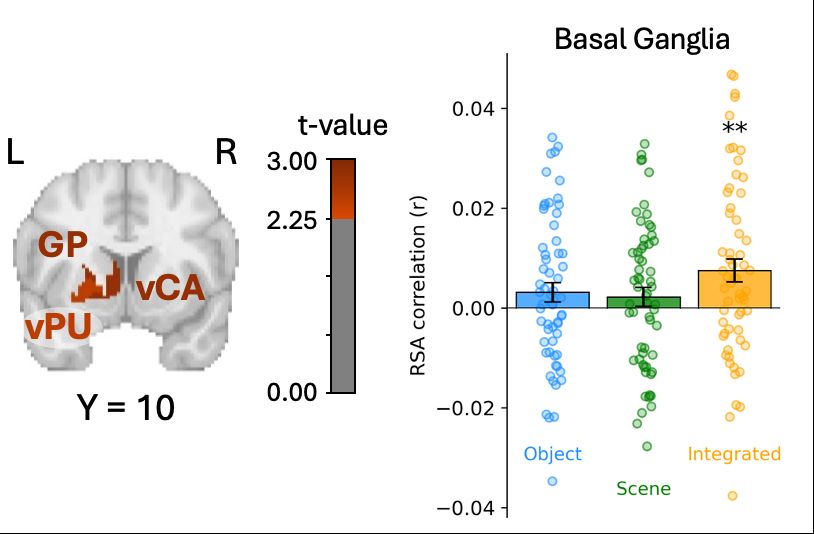
5/🧵 Relational analysis also identified a role of the dorsal striatum. Despite not being typically seen as an area for semantic coding, striatal regions robustly represent relational content, and the strength of this representation predicts participants’ judgments about item pairs
24.06.2025 13:49 — 👍 3 🔁 1 💬 1 📌 0
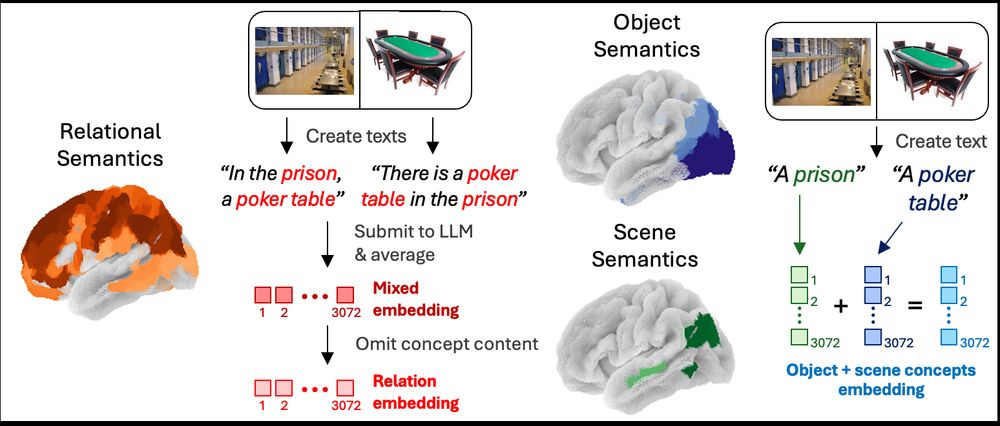
4/🧵 We used LLM embeddings to model neural representations via fMRI and RSA, which revealed dissociations in information processing. Occipitotemporal structures parse concepts but not relations. Conversely, frontoparietal regions (especially the PFC) almost exclusively encode relational information
24.06.2025 13:49 — 👍 7 🔁 2 💬 1 📌 0
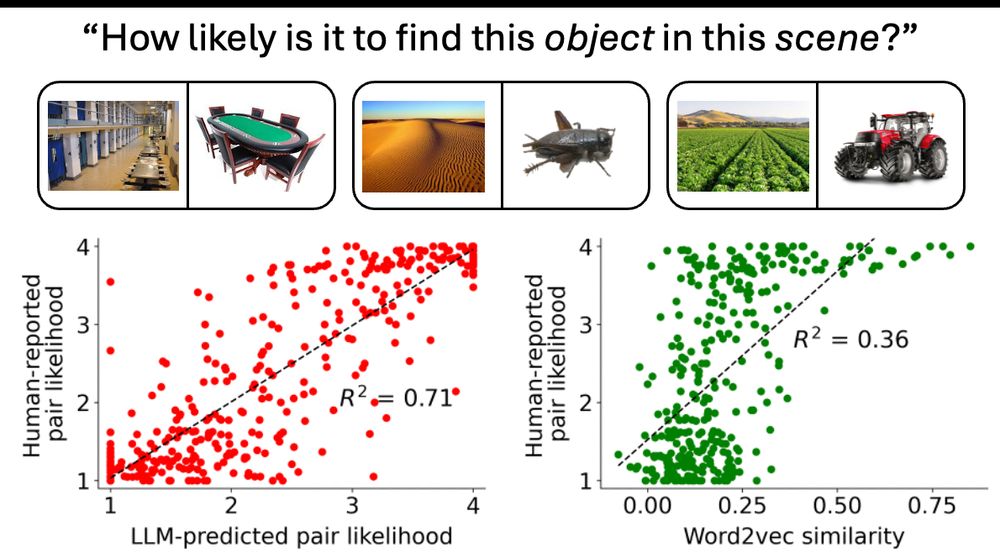
3/🧵 Next, we tested relational information. LLM activity for texts like “A prison and poker table” robustly predicts human ratings on the likelihood of finding a poker table in a prison. Further analyses show how LLMs parsing such texts also capture precise propositional relational features
24.06.2025 13:49 — 👍 1 🔁 1 💬 1 📌 0
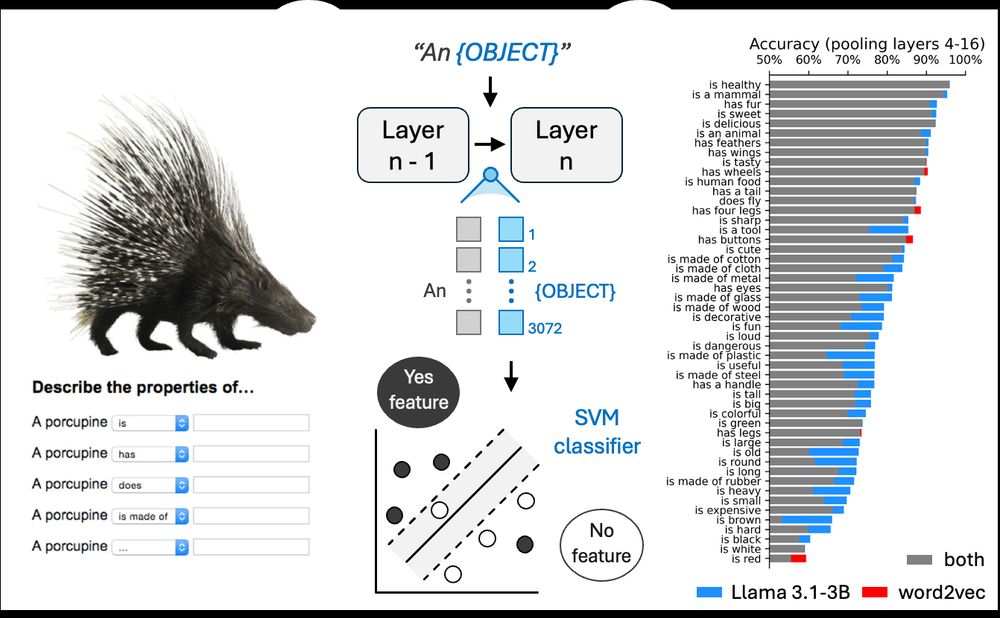
2/🧵 To produce concept embeddings, we submit a short text (“A porcupine”) to contemporary LLMs and extract the LLMs’ residual stream. Leveraging data from our normative feature study, we find that LLM embeddings better predict human-reported propositional features than older models (word2vec, BERT)
24.06.2025 13:49 — 👍 1 🔁 1 💬 1 📌 0

🚨 New preprint 🚨
Prior work has mapped how the brain encodes concepts: If you see fire and smoke, your brain will represent the fire (hot, bright) and smoke (gray, airy). But how do you encode features of the fire-smoke relation? We analyzed fMRI with embeddings extracted from LLMs to find out 🧵
24.06.2025 13:49 — 👍 32 🔁 8 💬 1 📌 2
I figure the results showing how, nowadays, stronger p-values are linked to more citations and higher-IF journals points to progress that is difficult to explain with just mturk
10.06.2025 21:37 — 👍 0 🔁 0 💬 0 📌 0
Another bit from the paper, perhaps consistent with your message: "there remain many studies publishing weak p values, suggesting that there have still been issues in eliminating the most problematic research. This deserves consideration despite the aggregate trend toward fewer fragile findings."
10.06.2025 21:23 — 👍 0 🔁 0 💬 0 📌 0
Averaging to 26% isn't "mission accomplished", but this 26% value (or, say, 20% per Peter's simulations) still seems like a meaningful reference. Considering it seems more informative than just expecting 0% (i.e., seeing 33 ➜ 26% as just eliminating only 7/33 of problematic studies)
10.06.2025 21:18 — 👍 0 🔁 0 💬 0 📌 0
I figure the most appropriate conclusion would be that there are many studies achieving >80% power along with numerous studies below this
10.06.2025 21:14 — 👍 0 🔁 0 💬 0 📌 0
> But it should be obvious that the problem in psychology was not that 6% of the papers had p-values in a bad range.
I also talk about this 6% number in this other thread: bsky.app/profile/did:...
10.06.2025 18:13 — 👍 0 🔁 0 💬 0 📌 0
Although we certainly shouldn't conclude that the replication crisis is over, it seems fair to say that there has been productive progress
10.06.2025 18:12 — 👍 0 🔁 0 💬 1 📌 0
Continuing on this response to "The replication crisis in psychology is over", it is also worth considering psychology's place relative to other fields. Looking at analogous p-value data from neuro or med journals, only psychology seems to make a meaningful push to increase the strength of results
10.06.2025 18:11 — 👍 0 🔁 0 💬 0 📌 0
The replication crisis is certainly not over, and the paper always refers to it as ongoing. However, I wonder what is the online layperson's view of psychology replicability. The crisis entered public consciousness, but I doubt the public is as aware of the progress to increase replicability
10.06.2025 18:09 — 👍 0 🔁 0 💬 0 📌 0
Small take on your COVID vaccine example, a p-value of p = .01 based on a correlation seems intuitive? Flip a coin 10 times and you'll get heads 9 times 1% of the time. Yet, Pfizer and society should act strongly on that result given their priors on efficacy and given the importance of the topic
10.06.2025 18:04 — 👍 0 🔁 0 💬 0 📌 0
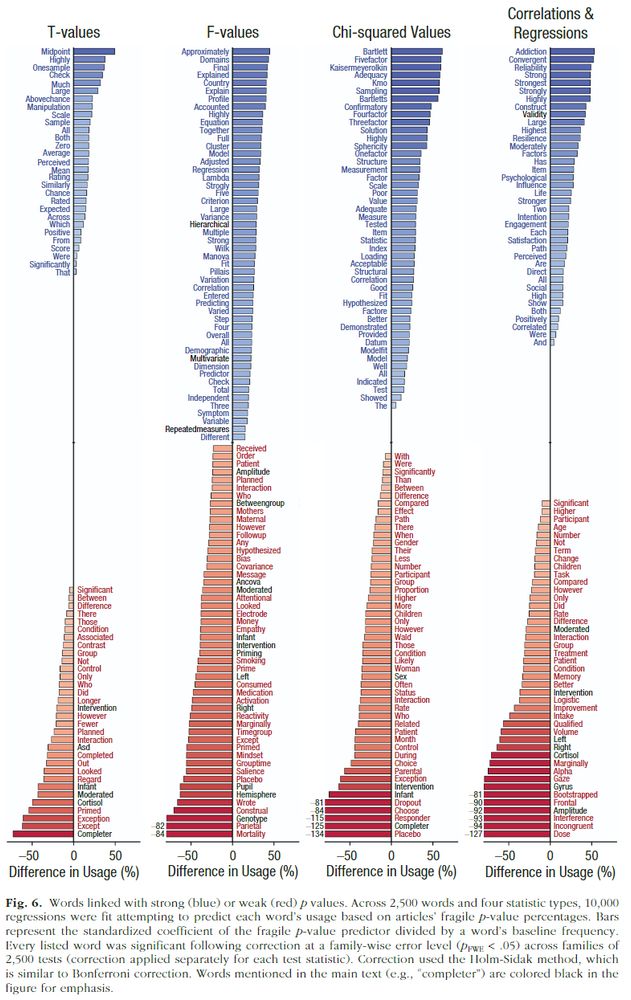
I agree that trying to convert aggregate p-values into a replication rate won't be reliable. Nonetheless, a paper's p-values seem to track something awfully related to replicability. Per Figure 6, fragile p-values neatly identify numerous topics and methods known to produce non-replicable findings
10.06.2025 17:57 — 👍 0 🔁 0 💬 0 📌 0
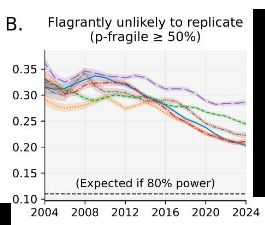
Not sure how informative this would be, but an earlier draft included a subfigure trying to demonstrate that there remain a substantial number of likely problematic papers. Somewhat arbitrarily, the figure showed the percentage of papers where a majority of significant p-values were p > .01
10.06.2025 17:32 — 👍 0 🔁 0 💬 0 📌 0
I regret not exploring this ~26.4% number more or having a paragraph on why a rate of 26.4% likely wouldn't correspond to entirely kosher studies. Your 16% and 20% results, if I'm reading this correctly, are based on some studies having above 80% power, which seems like a correct assumption
10.06.2025 17:27 — 👍 1 🔁 0 💬 1 📌 0
Hi Peter, thanks for these additional analyses. For my simulations of 80% power, I sampled z-scores from a distribution centered at 2.8. This only has a small effect (~0.4%), but I also accounted for the number of p-values each actual paper in the dataset reported then computed the average
10.06.2025 17:15 — 👍 1 🔁 0 💬 0 📌 0
If all studies are either 80% power or 45% power, a 32% level of fragile p-values implies that 25% of studies are questionable.
This math isn't meant to argue that 25% of studies were questionable but to show why a 32% fragile percentage can suggest a rate of questionable studies presumably >6%
10.06.2025 17:01 — 👍 0 🔁 0 💬 1 📌 0

Let's define a study as questionable if it doesn't have 80% power when the sample size as 2.5x. Eyeballing based on playing with G*Power, this means a questionable study is one with <45% power. An effect with 45% power will produce a fragile (.01 < p < .05) p-value about 50% of the time
10.06.2025 17:00 — 👍 0 🔁 0 💬 0 📌 0
Hi, I'm only seeing this thread now.
>it implies that ~6% of the literature was questionable
Sorry about giving off this impression as it is not at all what I had in mind. No doubt, much more than 6% of the literature remains questionable even today
10.06.2025 16:56 — 👍 0 🔁 0 💬 0 📌 0
This isn't on my website, but I also have gathered data on medical journals (e.g., oncology, surgery). I'm not an MD, but my feeling is that much medical research has perhaps bigger replicability issues than psych or neuro. I encourage any med academic interested in that direction to contact me
06.06.2025 22:54 — 👍 2 🔁 0 💬 0 📌 0
My feeling is that cog neuro has less confronted replicability issues (at least the subset of cog neuro reporting p-values). I don't plan to pursue a cog neuro paper, but anybody interested is free to reach out to me for the data, including data linking p-values to specific portions of text
06.06.2025 22:51 — 👍 2 🔁 0 💬 0 📌 0

‘A big win’: Dubious statistical results are becoming less common in psychology
Fewer papers are reporting findings on the border of statistical significance, a potential marker of dodgy research practices
Thrilled to see a news piece by @science.org on my recent paper. By analyzing p-values across >240k papers, the study suggests that the rate of statistically questionable findings in psychology has declined since the replication crisis began
www.science.org/content/arti...
06.06.2025 19:19 — 👍 123 🔁 35 💬 3 📌 3
"Depression" and "anxiety" have a perfect storm going for them, intersecting clinical and personality research, being a common covariate... I figure, depression and anxiety are also some of the easier clinical conditions to study (e.g., many schools wouldn't have access to schizophrenia patients)
03.06.2025 10:10 — 👍 0 🔁 0 💬 0 📌 0
Of course, and yeah every tenth paper is nutty (among 30% of papers in clinical journals), and still hard to believe. Anxiety's at 11%. These are perhaps the most unexpected overall rate's I've seen for any word
03.06.2025 10:07 — 👍 1 🔁 0 💬 0 📌 0
I suspect that this stems from depression measurements (e.g., the BDI) being some of the most common questionnaires administered
02.06.2025 19:51 — 👍 1 🔁 0 💬 1 📌 0
depression dois - Pastebin.com
Pastebin.com is the number one paste tool since 2002. Pastebin is a website where you can store text online for a set period of time.
That's neat. Seeing this actually made me concerned that there was a bug, I can indeed find ~31k papers with p-values that contain "depression" in their Results (pastebin won't let me paste all of them, but here are ~2.5k: pastebin.com/8xy1uTXC); 31k is about 10% of the dataset used for the site
02.06.2025 19:49 — 👍 1 🔁 0 💬 1 📌 0
The biggest danger I envision is that researchers could start aggressively p-hacking to achieve p < .01 or p < .001 (e.g., excluding multiple contradictory data points or tweaking multiple researcher degrees of freedom). I figure that this isn't a major issue yet but may happen in the future
02.06.2025 16:15 — 👍 7 🔁 0 💬 1 📌 0
Neuroscientist at the University of Leeds, working on #EEGManyLabs, #rsatoolbox, co-founder mead.ac, tpc chair at ccneuro.org
interested in multi-sensory representations, semantics, neuroinformatics, open science
postdoc on cognitive neuroscience. I’m interested in mental imagery, mental simulation and aphantasia.
my website: https://jianghao-liu.github.io
Cognitive Neuroscientist; interested in understanding how memory changes as we age; I also love cats and running marathons
Senior Scientist, Rotman Research Institute
Associate Professor, Psychology, University of Toronto
https://www.olsenmemorylab.com/
AI in Bio & Health & Therapeutic Development
Bio: https://linktr.ee/mnarayan
Substack: https://blog.neurostats.org
Peek into my brain: notes.manjarinarayan.org
Previously @dynotx @StanfordMed PhD@RiceU_ECE | BS@ECEILLINOIS
🧪🧮⚕️🧬🧠🖥🤖📈✍️🩺👩📈📉
UF Assistant Professor. Attention, Perception, Consciousness.
Philosopher, phenomenologist, and cognitive scientist at
UC Merced. Interested in neural networks and dynamical systems theory. Builder of simbrain.net and husserl.net. Website: https://jeffyoshimi.net/
neuroscientist in Korea (co-director of IBS-CNIR) trying to make human fMRI more interesting & effective (for e.g. causal interventions) by using animal models (sometimes). https://tinyurl.com/hakwan
Seeking superhuman explanations.
Senior researcher at Microsoft Research, PhD from UC Berkeley, https://csinva.io/
Always was, always will be
https://www.un.org/en/about-us/universal-declaration-of-human-rights
PhD student in neuroscience
NeuroSpin & LSCP (ENS)
Postdoctoral researcher @birkbeckpsychology.bsky.social @audioneurolab.bsky.social | speech + sounds + brains 🧠 cognitive sci, auditory neurosci, brain imaging, language, methods https://mkachlicka.github.io | 🔍 Looking for a new role from Oct 2025 🔍
Theoretical Scientist | Researcher & Philosopher
Head of Research Department, RO Educational Institute
https://www.researchgate.net/profile/Jalal-Khawaldeh
https://orcid.org/0009-0003-7872-1967
Retired Sociology/Demography professor. I know the United States has an awfully high middle aged death rate. My goal is to explain it well enough to get people to fix it.
#rstats | compbio | zigma
Quantitative science studies, Meta-research, Research evaluation, Science policy, Research integrity, Statistics - Bayesian and a proud methodological terrorist
X & mastodon: @schneider_jw
Research Scientist at the University of Washington based in Brooklyn. Also: SFI External Applied Fellow, Harvard BKC affiliate. Collective Behavior, Statistics, etc..
Director, Statistics for Development Division, at the Pacific Community. Tweets only represent my views, and are most likely to be about data and #rstats, maybe with bits of history, social science and philosophy thrown in.
PhD Candidate @ Maastricht University & NSMD New Science of Mental Disorders | Mental Health as Complex Systems | Transdiagnostic | Personality & Identity | ESM/EMA | she/her
Professor (michaelinzlicht.com), Podcaster (www.fourbeers.com), Writer (www.speakandregret.michaelinzlicht.com)








